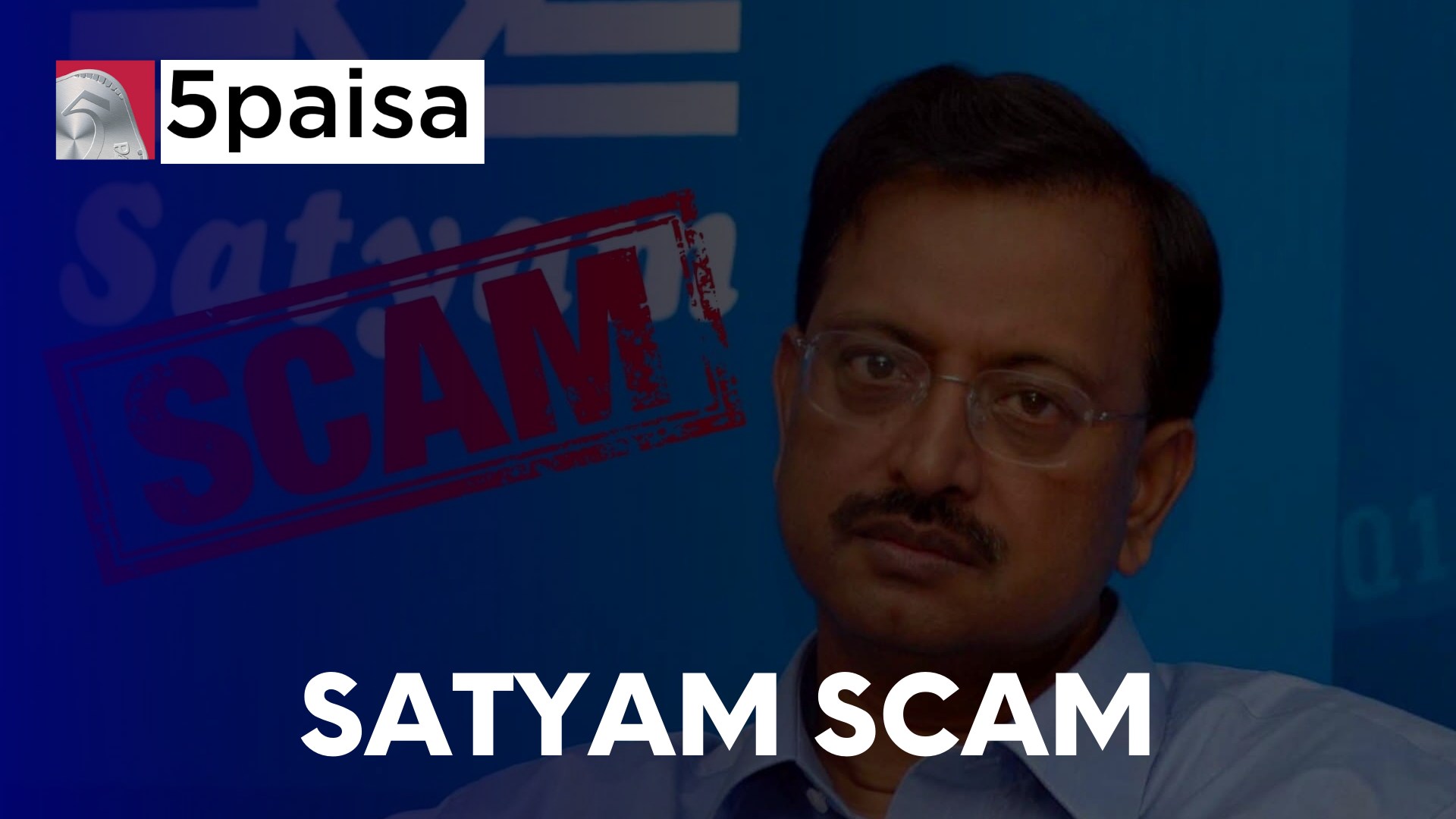Why Stock Market Returns Outperform Most Asset Classes in the Long Run
Satyam Scam

Last Updated: 3rd October 2025 - 01:08 pm
Introduction
The Satyam scam is one of the biggest accounting scams in India. The scam was done by the company Satyam Computers. Satyam Computers was formerly the crown jewel of the Indian Information Technology (IT) industry, but its founders brought it to its knees in 2009 owing to financial misconduct. Satyam's abrupt demise spurred a discussion over the CEO's role in driving a company to new peaks of success, as well as the CEO's interaction with the Board of Directors and the establishment of crucial committees. The controversy highlighted the significance of corporate governance (CG) in the development of auditing committee standards and member of the board duties. The Satyam scam case shocked the market, especially Satyam investors, and it also harmed India's image in the worldwide market. So, let's delve into the topic by understanding what is Satyam scam.
What is Satyam Scam?
Satyam scam means a huge corporate fraud committed in 2009 by Ramalinga Raju, the founder and chairman of Satyam Computer Services. He admitted to exaggerating sales, earnings, cash balances, and personnel numbers in the company's books. He also acknowledged siphoning off money from the firm for his personal use. The Satyam fraud was considered worth Rs. 7800 crores and was formerly regarded as India's largest business scandal.
The Satyam scam highlighted a lack of corporate governance, auditing standards, regulatory monitoring, and ethical behavior at one of India's largest IT firms. It also damaged the faith and confidence of Indian IT sector investors, consumers, workers, and stakeholders. The Satyam Computers scam had serious consequences for the corporation, its auditors, its board of directors, and its stockholders.
Understanding Satyam Scandal - India's Biggest Accounting Fraud
The Satyam Computers scam exemplifies one of India's most catastrophic scams, sending shockwaves across the business world. Ramalinga Raju, the founder and chairman of Satyam Computer Services, admitted to falsifying the company's accounting for many years in 2009. This disclosure surprised investors, workers, and regulators, ruining Satyam's and the Indian business community's image.
The Satyam scam was a methodically planned effort to defraud stakeholders. Raju and a small group of accomplices increased sales, earnings, and cash levels, providing a false sense of financial accomplishment. Forging bank statements, faking invoices, and inflating customer numbers were all part of the fraudulent operations. Auditors tasked with protecting shareholders' interests failed to discover the anomalies, showing the failure of corporate governance processes.
The results were devastating. Share prices fell precipitously, causing substantial capital destruction for investors. As the corporation fought to survive, thousands of workers faced uncertainty. The Satyam scandal damaged local and foreign investors' faith in India's business sector, generating concerns about transparency, accountability, and ethical standards. Following the incident, the Indian government intervened to avert Satyam's collapse and preserve stakeholders' interests. Tech Mahindra finally purchased the firm, kicking off a lengthy path to recovery. The episode was a wake-up call for Indian regulators, prompting substantial changes in corporate governance, accounting methods, and audit rules.
The Satyam controversy is a sharp reminder of the significance of strong regulatory supervision, ethical behavior, and good corporate governance in sustaining company confidence and integrity.
Satyam Scam Case Study: How Did the Raju Brothers Do Satyam Scam?
In 2003, Raju started falsifying Satyam's financial records to depict a more rosy image of growth and profitability than the firm has actually accomplished. Raju participated in a web of deception with his brother Rama Raju, Satyam's managing director, and a group of top executives, faking audit reports and generating bogus invoices, clients, bank accounts, and even employees. To make things worse, Raju used Satyam's finances to invest in his family's enterprises, such as Maytas, for personal benefit in real estate and other projects.
Raju deceived authorities, auditors, investors, and analysts for six years, who were caught off guard by his faked data and bogus awards. In 2008, Satyam's stock price jumped from Rs. 10 to Rs. 544, making it one of India's most valuable IT firms. The firm has also received social responsibility and corporate governance awards, including the Golden Peacock Award in 2008.
However, the facade started to disintegrate towards the end of 2008, coinciding with the global financial crisis, which ravaged the IT sector. Raju faced increased pressure from lenders and creditors to settle his obligations as Satyam's sales and profitability decreased. Furthermore, the World Bank examined his behavior and barred Satyam from participating in its projects for eight years owing to Raju's illicit employee benefits.
In a desperate effort to save his disintegrating enterprise, Raju used Satyam's financial reserves in December 2008 to launch an ill-fated $1.6 billion offer for Maytas. This strategy, however, backfired catastrophically, sparking a furious uproar from Satyam shareholders and board members who saw the transaction as a diversion of cash and a blatant conflict of interest. Raju had just 12 hours to cancel the deal, but Satyam's stock price had dropped by 55% by then.
Raju ultimately admitted to his deceptions after being cornered and given no other choice. On January 7, 2009, he acknowledged inflating Satyam's assets by a stunning Rs. 7,800 crores, accounting for approximately 94% of the company's assets, in a letter to Satyam's Board of Directors and authorities. Furthermore, he admitted to overstating Satyam's revenues by Rs. 5,040 crores, accounting for nearly 75% of the company's revenue. Raju said he worked independently and that neither his auditors nor board members knew of his illegal operations.
The Serious Fraud Inquiry Office (SFIO), the Securities and Exchange Board of India (SEBI), and the Central Bureau of Investigation (CBI) launched a thorough inquiry in response to Raju's admission. Raju and his associates were caught and charged with various offences, including money laundering, insider trading, forgery, criminal conspiracy, breach of trust, account falsification, and forgery.
The aftermath of the Satyam Computers scam left Satyam's workers, customers, investors, and suppliers fearful and apprehensive. Layoffs, project cancellations, and unpaid dues beset the firm, leaving a destructive path in their wake.
Government’s Reaction to Satyam Scam
The Satyam fraud case taught India a lot. Indian law is continually evolving. However, this is how the government responded to the Satyam Scam:
|
Steps |
Description |
|
Companies Act
|
1 - The Companies Act of 1956 was abolished, and the Companies Act of 2013 took effect. Corporate fraud is a criminal offence under the new act's terms. The statute explicitly defines and identifies cost accountants, auditors, and corporate secretaries as obligated to disclose Satyam fraud. 2- A new provision for auditor rotation was also implemented, requiring auditors to be replaced after five years and audit firms to be changed after ten years. It also states that the Director's Responsibility Statement should be included in the Board of Directors' Report. |
|
ICAI- The Institute of Chartered Accountants of India |
The accounting organization underlined the auditors' comprehensive reporting of fictional assets & contingent liabilities in its audit report. |
|
SEBI |
The SEBI Regulations 2015 (Listing Obligations and Disclosure Requirements) were enacted, and they established criteria for reporting actual and suspected frauds and disclosing important events that influence the decision-making ability of investors. |
|
Serious Fraud Investigation Office (SFIO)
|
This regulatory authority, constituted under the administration of the Ministry of Corporate Affairs, was given the status of a statutory organization under the Companies Act of 2013. In India, it looks into business and accounting fraud. Corporate governance best practices have become an urgent need. |
Who Exposed the Satyam Scam?
The Satyam scam was exposed by an anonymous whistleblower who sent emails to one of the company’s directors, Krishna Palepu, revealing the fraud. Palepu forwarded the emails to another director and S. Gopalakrishnan, a partner at PwC, the auditor of Satyam. The emails were sent from the alias Joseph Abraham. The whistleblower also alerted the SEBI and the media about the scam. The emails prompted an investigation by the regulators and the auditors, eventually leading to Raju’s confession and arrest.
Satyam Scam Case Study: How Raju was Able to Get Away with the Scandal?
Raju got away with the Satyam scam for six years by exploiting flaws in the accounting and auditing procedures and deceiving stakeholders with his power and charm. He had a network of accomplices with his brother Rama Raju, Satyam's managing director, and several senior executives. He also paid World Bank officials and other clients to get contracts and evade inspection.
PricewaterhouseCoopers (PwC), Satyam's auditor, was Raju's key ally in the scheme. PwC failed to undertake its obligation of evaluating Satyam's financial statements and discovering fraud. PwC violated auditing standards and the code of conduct and was involved in falsifying the accounts with Raju. PwC also overlooked red signals from whistleblowers who revealed the theft in anonymous emails to one of Satyam's directors, Krishna Palepu.
Raju also utilized his influence and reputation to gain the confidence and admiration of regulators, investors, analysts, and the media. He depicted Satyam as a successful and ethical firm, collecting multiple corporate governance and social responsibility awards. He was also recognized for his commercial skills and entrepreneurship. He kept a low profile and a modest manner to avoid suspicion or criticism.
Raju's scheme was discovered in 2009 when he attempted to purchase Maytas, a family-owned real estate firm, using Satyam's financial reserves. This decision backfired, resulting in a major outcry from Satyam's shareholders and board members.
Raju decided to come clean and admit his deception with no other option. On January 7, 2009, he admitted in a letter to Satyam's board and regulators that he had overstated Satyam's assets by Rs. 7,800 crores, or almost 94% of its total assets. He said he operated alone and that none of his board members or auditors knew of his deception.
Highlights of the Satyam Scandal
● Satyam had won the Golden Peacock Award for Corporate Accountability in 2008, around five months before the Satyam scam was revealed.
● The same year, Mr Ramlinga Raju received the Ernst and Young Young Entrepreneur Award.
● When read backwards, SATYAM is MAYTAS, the real estate business Mr Raju sought to buy.
● Satyam was barred from conducting business with its connections for an eight-year term by the World Bank.
● PwC, the external audit company, has been barred from providing assurance and auditing services to publicly traded firms for over two years.
● Satyam is known as the "Enron Scandal of Indian History." Enron was the largest accounting and business fraud in the United States, contributing to Wall Street's demise.
Conclusion
The Satyam scam case demonstrates how human avarice and ambition influence behavior. The Satyam scandal emphasizes the need for ethics, solid governance, and accounting standards. Securities legislation and corporate governance are required in emerging markets such as India. Satyam Computers scam sparked more strict regulations. Investigating big financial crimes aids in the prevention of future incidents and encourages best practices.
Frequently Asked Questions
Who is to blame for the Satyam scam?
How were Satyam books cooked?
What happened to PwC after the Satyam scandal?
Who acquired Satyam?
Why did Mahindra acquire Satyam?
- Flat ₹20 Brokerage
- Next-gen Trading
- Advanced Charting
- Actionable Ideas
Trending on 5paisa
02
 5paisa Capital Ltd
5paisa Capital Ltd
Indian Stock Market Related Articles
Disclaimer: Investment in securities market are subject to market risks, read all the related documents carefully before investing. For detailed disclaimer please Click here.




